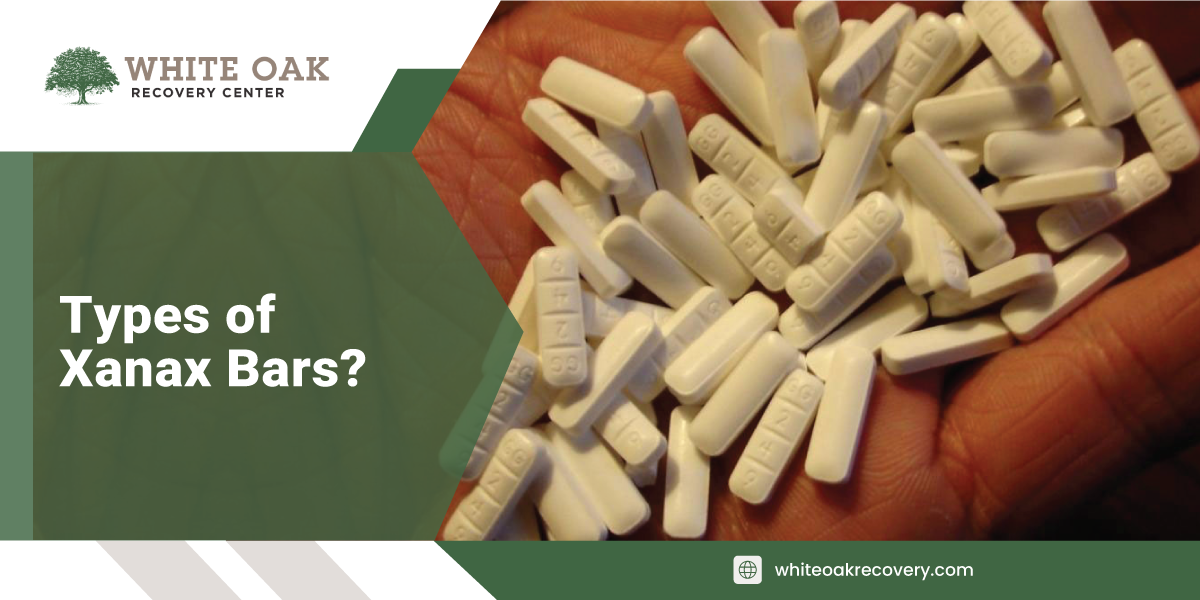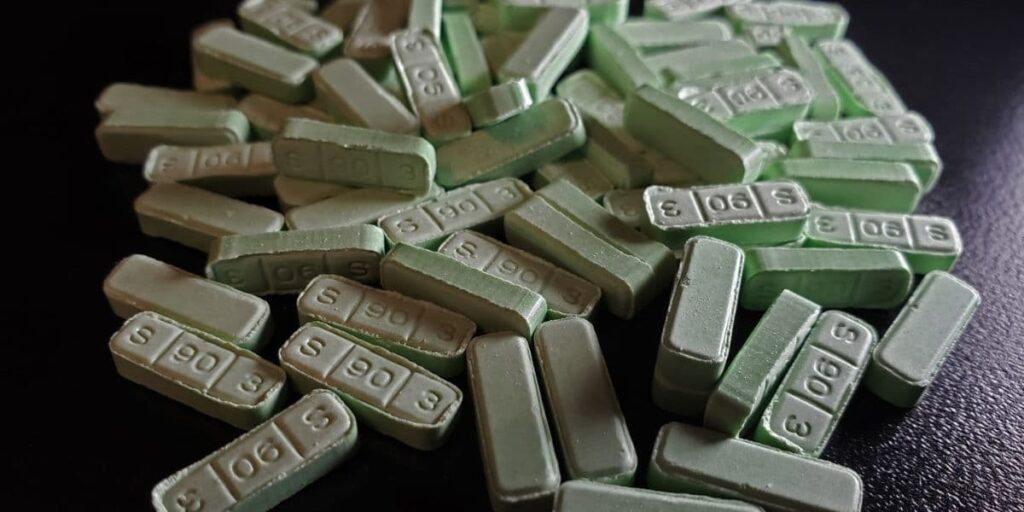Types of Xanax Bars


Medical Writer:
Reviewer:

Johnny Kim
Executive Psychotherapist
Medical Writer:
Reviewer:

Johnny Kim
Executive Psychotherapist
Xanax, a brand name for alprazolam, is a commonly prescribed medication for treating anxiety and panic disorders. It’s a central nervous system depressant that belongs to the benzodiazepine class of drugs and works as a sedative. Xanax bars are characterized by their distinct shapes, colors, and dosages.
It is important for patients and healthcare providers to know the different types of Xanax bars. This knowledge helps them to be used correctly and avoid dangers from fake Xanax bars or improper use.
Table of Contents
Toggle
What Are Xanax Bars?
Xanax bars are rectangular tablets typically scored into smaller segments to allow for easy division of doses. These alprazolam bars come in various colors and strengths, each intended to meet specific therapeutic needs. The scoring will enable patients to take smaller doses if necessary, providing flexibility in managing anxiety symptoms.
Various Xanax bars are available on the street, including fake ones. This has raised concerns about their safety and potential for misuse.
Xanax, as a controlled substance, is commonly prescribed for conditions like generalized anxiety disorder, panic disorder, and sometimes insomnia. The medication helps calm anxiety and panic by boosting certain brain chemicals. Different types of Xanax bars are made for varying levels of symptoms. It’s important to know the distinctions between them.

Real vs Fake Xanax
Fake Xanax is a big problem because it can have dangerous ingredients and cause health problems. Real Xanax is prescribed by a doctor and bought from a licensed pharmacy to make sure it is safe and effective. Fake Xanax, often sold on the street, can be difficult to distinguish from the real product. These counterfeit tablets may contain dangerous additives or incorrect dosages, leading to life-threatening consequences.
Identifying fake Xanax involves several key factors, including its appearance, taste, and effects. Prescribed Xanax bars typically have a uniform color and shape, with precise imprints indicating the manufacturer and dosage. Fake Xanax may look similar but often has inconsistencies in color, size, or imprint details.
Fake Xanax can be dangerous because it may contain substances like fentanyl. Fentanyl can cause severe breathing problems and even death.
Patients should only get their medication from trusted sources and talk to their healthcare provider if they think they have fake Xanax. The risks associated with fake Xanax highlight the importance of strict regulations and the need for awareness among consumers.
Understanding the different types of Xanax bars, their intended uses, and the potential risks associated with misuse is vital for safe and effective treatment. Patients should always consult with their healthcare provider and obtain their medication from licensed pharmacies to avoid counterfeit products. Awareness and education about Xanax can help prevent abuse and ensure that those in need receive the appropriate care.
Strengths and Types of Xanax Bars
Xanax bars are made in various strengths, typically indicated by their color and shape. Each type serves a different purpose and is prescribed based on the patient’s needs.
White Oval – 0.25 MG
The white oval Xanax bar is the lowest dose available, containing 0.25 mg of alprazolam. It is often prescribed for patients who need smaller doses to manage their anxiety or panic disorders. This dosage is suitable for people sensitive to higher doses and helps minimize the risk of side effects.
This Xanax is often prescribed to new patients or those with low tolerance to benzodiazepines. It is used as a starting dose. A smaller dose helps doctors see how the patient reacts to the medicine and change the amount if necessary. It also helps reduce the likelihood of side effects such as drowsiness, dizziness, and impaired coordination.
Peach Oval – 0.5 MG
Peach oval Xanax bars contain 0.5 mg of alprazolam and are commonly prescribed for moderate anxiety relief. This dosage balances efficacy and safety, providing a calming effect without the intensity of higher doses. It is a frequently prescribed strength due to its effectiveness in treating generalized anxiety disorder and other related conditions.
The 0.5 mg dosage is for patients who need strong relief from anxiety but don’t need the highest doses. It helps calm the mind and reduce physical symptoms of anxiety.
These symptoms include a fast heartbeat and sweating. This is achieved by providing a mild sedative effect. Patients on this dosage are typically monitored to ensure they do not develop tolerance or dependence on the medication.
Blue Oval – 1 MG
Blue oval Xanax bars with a 1 mg dosage are for severe anxiety and panic disorders. The higher dosage provides a stronger sedative effect, helping to alleviate intense symptoms. Patients given this dose are closely watched by their doctor to ensure they use it correctly and avoid side effects.
This amount is commonly given to patients who haven’t improved with lower doses or have very bad anxiety. The 1 mg dosage is stronger.
You need to manage it carefully to avoid side effects, such as excessive sleepiness, confusion, and difficulty moving. Healthcare providers may adjust the dosage over time based on the patient’s response and any side effects experienced.
White Xanax Bars – 2 MG
The white bar Xanax, containing 2 mg of alprazolam, is the highest standard dosage available in bar form. This strength is used for severe anxiety and panic disorders that do not respond to lower doses. Because of its potency, it carries a higher risk of side effects and dependency. Patients on this dosage require careful medical supervision to manage these risks effectively.
The 2 mg dosage is typically reserved for patients with severe anxiety who have not found relief with lower doses. It provides a powerful sedative effect, helping to calm the mind and body during intense episodes of anxiety or panic. Because of its high potency, patients are at an increased risk of developing tolerance and dependence, making it crucial to use this medication under strict medical supervision.
Yellow Xanax Bars
Yellow Xanax bars are called “school buses” or “french fries” because of their shape and color. They usually have 2 mg of alprazolam. These bars are similar in potency to the white bars and are used to treat severe anxiety and panic disorders.
The color and imprints on these bars help distinguish them from other dosages and forms of Xanax. Like other high-dose Xanax bars, they carry a significant risk of dependency and require careful management.
Pink Xanax
Pink Xanax bars contain 0.5 mg of alprazolam, similar to the peach oval bars. They are less common but serve the same purpose of providing moderate anxiety relief. The pink color is distinctive, making them easily identifiable. These bars offer a calming effect suitable for managing moderate anxiety symptoms without the high potency of larger doses.
Purple Xanax Bars
Purple Xanax bars are another variant, often containing 1 mg or 2 mg of alprazolam. These bars are less commonly prescribed but are used for similar purposes as other high-dose Xanax bars. The purple color makes it easy for patients and healthcare providers to identify the dosage and type of medication.
Side Effects of Xanax
Like all medications, Xanax has a range of potential side effects. Common side effects include drowsiness, dizziness, and dry mouth. More serious side effects can occur, such as memory problems, difficulty concentrating, and changes in appetite.
Using Xanax for a long time can make you dependent and lead to drug abuse. Patients should follow their prescribed dose carefully. High doses or misuse can result in more severe consequences, including life-threatening conditions.
Some patients may experience opposite reactions to Xanax, such as increased anxiety, agitation, and even hallucinations. These rare reactions highlight the importance of careful monitoring and individualized treatment plans.
Patients should promptly inform their doctor of any unusual or severe side effects. Patients need to communicate any changes in their condition to their doctor. This will allow the doctor to adjust the treatment if needed and ensure that they receive the most appropriate care
Other side effects can include:
- Sedative Effect: While this is the intended purpose of Xanax, excessive sedation can impair daily functioning
- Cognitive Impairment: Long-term use can affect memory and cognitive abilities
- Physical Dependence: Prolonged use can lead to tolerance, requiring higher doses to achieve the same effect, which increases the risk of addiction

Withdrawal Symptoms of Xanax
Stopping Xanax abruptly, especially after long-term use, can lead to withdrawal symptoms. These common symptoms may include anxiety, insomnia, headaches, and nausea.
In severe cases, withdrawal can cause seizures and other serious health issues. It is crucial to taper off Xanax under medical supervision to minimize these risks. Xanax users are advised to seek professional help when discontinuing use to ensure a safe and effective withdrawal process.
The withdrawal process involves slowly lowering the dosage over time so the body can adjust to less medication. This tapering process helps to mitigate withdrawal symptoms and reduce the risk of severe complications. Patients undergoing withdrawal may benefit from supportive therapies, such as cognitive-behavioral therapy (CBT), to address the underlying anxiety and develop healthy coping strategies.
Other withdrawal symptoms can include:
- Xanax Overdoses: Mismanagement of withdrawal can lead to taking excessive amounts to counteract withdrawal symptoms
- Life-Threatening Symptoms: In severe cases, withdrawal without medical supervision can lead to critical conditions requiring emergency intervention
- Cold Turkey Risks: Abrupt cessation, known as going “cold turkey,” can be particularly dangerous and is generally not recommended without medical guidance
Xanax Addiction Treatment at White Oak Recovery Center
Addressing Xanax addiction requires a comprehensive approach, and White Oak Recovery Center (WORC) offers extensive, specialized addiction treatment programs for people struggling with substance use disorders.
WORC’s evidence-based treatment programs include medical detox, individual and group therapy, dual diagnosis, and medication-assisted treatment, all tailored to meet the needs of each patient. With the professional and compassionate guidance at WORC, you can overcome addiction and work towards a healthier, drug-free life.
White Oak Recovery Center provides an intensive, inpatient approach to treatment, addressing the physical, emotional, and psychological aspects of addiction. The medical detox program helps manage withdrawal symptoms and ensures a safe transition off Xanax. Therapy sessions, like one-on-one and group counseling, help patients figure out why they are addicted and make plans to stay sober. Support groups help patients feel connected and motivated, helping them create a strong network for their recovery process.
Our caring treatment specialists are eager to help you. A phone call can be the opportunity to reclaim your life. Contact WORC today.

Am I covered for addiction treatment?
Your insurance may cover treatment. Call now for an entirely free and confidential assessment. Recovery starts with a phone call.

- “Xanax-Alprazolam Tablet.” Daily Med: National Library of Medicine, Jan. 2023.
- “Geroge, Tobin T., and Tripp, Jayson, “Alprazolam.” StatPearls: National Library of Medicine, Apr. 2023.
- “Alprazolam.” ” National Institute of Diabetes and Digestive and Kidney Diseases, Jun. 2023.
- “Xanax, Alprazolam Tablets.” Food and Drug Administration, Mar. 2011.
Medical Disclaimer:







